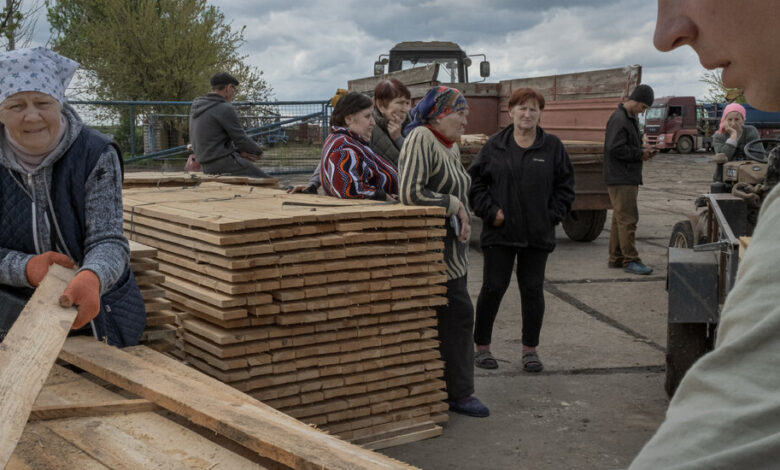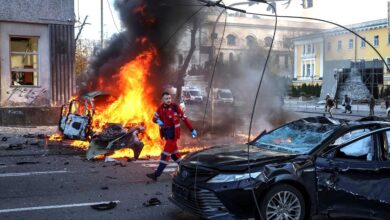Kherson Residents Rebuild and Prepare for New Russian Offensive

A row of twin concrete pyramids runs along undulating farmland outside the city of Kherson. Anti-tank fortifications known as dragon’s teeth, the pyramids are a sign of the new defense system Ukraine is building in the south to fend off an anticipated Russian attack.
In a nearby village, residents focused on a more urgent task: donating construction supplies.
People in the Kherson region are slowly rebuilding their homes and livelihoods since a Ukrainian counteroffensive forced Russian troops out of the area west of the Dnipro River 18 months ago and ended a brutal occupation.
Many people have repaired their roofs, windows and doors, but as they begin planting and tending their vegetable gardens, they are preparing for another Russian attack.
“Anything can happen,” said Oksana, taking a break from weeding the flower bed in front of the house. Like most of those interviewed for this article, she only gave her first name out of fear of Russian reprisals. “There is talk of a major attack in May-June. We are told they will take back Kherson.”
Her two sons joined the army after the Russians were expelled, she said, complaining that they lacked weapons. “It’s difficult,” she said of the situation at the front.
For those who lived through eight months of Russian occupation, these memories raise fears that the Russians will be harsher the second time.
Oksana recounted how her family had to live under fire from Russian soldiers across the street and how her husband almost died when he was wounded in the neck by a shell explosion.
“It’s scary,” she said. Her face scrunched up as she began to cry.
Down the street, a veteran soldier, Oleksandr Kuprych, 63, kept a shotgun in the greenhouse and said he would use it if the Russians returned.
“I will send the women and children away,” he said. “And I will be here. I have my trench and my rifle.”
In his house there was also a Russian soldier’s helmet damaged by a long ax blow.
Mr. Kuprych said he killed the soldier with a hatchet and buried him and his rifle in the tree line above the village. The soldier was one of two who shot at villagers trying to climb the hill to find a cell phone signal.
“I was so angry that I put all my strength into that ax blow,” he said.
When Ukrainian soldiers recaptured the village, he showed them where the soldier was buried. They took away the body and the rifle but let Mr. Kuprych keep the helmet. This episode was written into a book about Kherson’s resistance under occupation.
Kherson’s rural communities are resilient but highly degraded. Some villages standing on the front lines were so devastated that only a few families were able to return to repair their homes. Electricity and gas are back on in most places, but water has to be trucked to some villages. Irrigation canals remained destroyed, leaving farms and businesses largely abandoned.
There are few jobs and most families live on handouts. International charities provided people with cows and cash to buy chickens and seeds.
Some of the largest villages such as Myrolyubivka are crowded with many families displaced from frontline communities. Green tarpaulins were covered over damaged roofs, and vegetable gardens were neatly tilled.
Yet these villages, less than 20 miles from the front lines, remain targets of Russian missiles and bombs. Myrolyubivka recently completed a large underground basement where students gather twice a week to study and play games. But before work on the basement was completed, Russian missiles struck the local hospital, destroying the entire compound and several houses.
“Let them die, you bastards,” Tamara, 71, said of the Russian army as she pushed her bicycle along the road. “I was tending my garden and the shells were flying over my head, and it just kept going boom, boom.”
In another village, community leader, Lyubov, experienced a series of devastation caused by the fighting in 2022. “Schools were damaged, kindergartens were damaged, cultural houses were damaged and disease The institute was destroyed,” she said. She asked that her last name and the name of the village not be published to avoid being targeted by Russian missiles.
She said the United Nations and international charities provided construction materials to people to repair more than 100 houses in the village, but 50 houses could not be repaired. “We are waiting for money for that,” she said.
Russian shelling was not the only source of difficulty. The Kakhovka Dam was destroyed last year, which led to widespread flooding in the Kherson region and the draining of the Kakhovka reservoir, lowered the water table and left several villages with wells infected or dry.
There are hundreds of hectares full of mines and unexploded ordnance. The fields were not tended, white ribbons fluttering on the weeds warned of land mines.
Officials say it will take years to remove the mines, but some farmers say they cannot wait. Some have paid private contractors to clear their fields. Others have begun scanning fields with metal detectors.
“We found anti-tank mines and anti-personnel mines,” a farmer and mechanic, Oleh, 35, said as he crouched beneath his tractor engine. “Every day is the same. Clearing landmines and sowing seeds.”
His village was located on the front line and was one of the most heavily damaged villages. Only a few families lived there and there were only 10 children because there was no school, said his wife, Maryna, 33.
Beneath the physical destruction lie the deep wounds of the occupation.
A dilapidated two-story house on the edge of the village of Pravdyne was once a Russian position during the occupation. Packs of Russian cigarettes and a packet of rations were scattered on the floor amid broken glass and rubble. Burnt armored vehicles lie in the distance.
At the beginning of the invasion, Russian troops killed six guards of an agricultural company and a 15-year-old girl accompanying them, blowing up the house they were staying in. Investigators exhumed their bodies after the occupation and found two of them had been shot in the head, according to details released by Kherson Regional Police. The filing cites a man who served in the Russian Marine Corps for his role in the killing.
Many families had men who went to the front or had relatives who died because of the war. “Who will answer for it?” said Naira, a psychologist whose niece’s husband was killed in the fighting.
While part of the urban population in southern and eastern Ukraine is of Russian origin, the rural population is predominantly Ukrainian. Very few villagers worked for the Russian government during the occupation. Some departed with the Russian army. One farmer, Viktor Klets, 71, said others were accused of collaboration and jailed by Ukrainian authorities.
However, he said, divisions are showing in the remaining community with petty jealousies and complaints about the amount of compensation people are allocated.
Mr. Klets said there are still Russian sympathizers in the village, but for now they have kept quiet. There was solidarity among those who survived the occupation, he said, but others who left and then returned accused them of robbing their homes.
Lena, 45, a neighbor standing next to him, said: “War has changed people. “It makes people meaner.”
About the future, villagers often quote the same proverb. “Life is like a long field,” Mr. Klets said. “Anything can happen along the way.”
Yuri Shyvala Contributor reported from Kherson, Ukraine.




